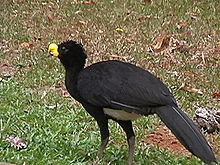- Great Curassow
-
Great Curassow 
male 
female rufous morph Conservation status Scientific classification Kingdom: Animalia Phylum: Chordata Class: Aves Order: Galliformes Family: Cracidae Genus: Crax Species: C. rubra Binomial name Crax rubra
Linnaeus, 1758Subspecies - Crax rubra rubra Linnaeus, 1758
Common Great Curassow - Crax rubra griscomi Nelson[verification needed], 1926
Cozumel Great Curassow
Synonyms - Crax chapmani
(barred morph female) - Crax globicera
- Crax hecki
(barred morph female) - Crax panamensis
The Great Curassow (Crax rubra) is a large, pheasant-like bird from the Neotropics. At 78–100 centimetres (31–39 in) in length and 3.1–4.8 kilograms (6.8–11 lb) in weight, this is a very large cracid.[1][2] No other cracid match its maximum weight, but its length is matched by a few other cracids.[1][3][4]
The male is black with a curly crest, a white belly, and a yellow knob on its bill.[1] There are three morphs of female Great Curassows:[1] Barred morph females with barred neck, mantle, wings and tail, rufous morph with an overall reddish brown plumage and a barred tail, and dark morph female with a blackish neck, mantle and tail (the tail often faintly vermiculated), and some barring to the wings. In most regions only one or two morphs occur, and females showing a level of intermediacy between these morphs are known (e.g. resembling rufous morph, but with black neck and faint vermiculations to wings).
A monogamous species, the Great Curassow is distributed in rainforest from eastern Mexico throughout Central America, to western Colombia and northwest Ecuador.[1] Its diet consists mainly of fruits, figs and arthropods.
Contents
Paleontology
The Great Curassow is the most northernly Crax species. It is part of a clade that inhabited the north of South America since about 9 mya (Tortonian, Late Miocene). As the Colombian Andes were uplifted around 6 mya, this species' ancestors were cut off from the population to their southeast. The latter would in time evolve into the Blue-billed Curassow. The ancestral Great Curassows then spread along the Pacific side of the Andes, and into Central America during the Pliocene and Pleistocene (Pereira & Baker 2004) as part of the Great American Interchange.
Ecology
Due to ongoing habitat loss and overhunting in some areas, the Great Curassow is evaluated as Vulnerable on the IUCN Red List of Threatened Species. It is listed on Appendix III of CITES in Costa Rica, Guatemala, Colombia and Honduras. Of the smaller subspecies griscomi of Cozumel Island, only a few hundred remain. Its population seems either to have been slowly increasing since the 1980s, or to be fluctuating at a low level; it is vulnerable to hurricanes (del Hoyo 1994, BirdLife International 2004, see also Cozumel Thrasher).
This species has proven to produce fertile hybrids with its closest living relative the Blue-billed Curassow, and also with the much more distantly related Black Curassow (del Hoyo 1994)
References
- BirdLife International (2009). "Crax rubra". IUCN Red List of Threatened Species. Version 2010.1. International Union for Conservation of Nature. http://www.iucnredlist.org/apps/redlist/details/141181. Retrieved 1 April 2010. Database entry includes a brief justification of why this species is vulnerable
- BirdLife International (2008): Great Curassow (Crax rubra): uplist to Vulnerable?. Accessed 17-01-2009.
- Pereira, , Sérgio Luiz & Baker, Allan J. (2004): Vicariant speciation of curassows (Aves, Cracidae): a hypothesis based on mitochondrial DNA phylogeny. Auk 121(3): 682-694. [English with Spanish abstract] DOI:10.1642/0004-8038(2004)121[0682:VSOCAC]2.0.CO;2 HTML abstract HTML fulltext without images
- ^ a b c d e del Hoyo, Josep (1994): 44. Great Curassow. In: del Hoyo, Josep; Elliott, Andrew & Sargatal, Jordi (editors) Handbook of Birds of the World, Volume 2 (New World Vultures to Guineafowl): pp. 359, Plate 33. Lynx Edicions, Barcelona. ISBN 84-87334-15-6
- ^ [1] (2011).
- ^ Restall, Rodner & Lentino (2006): Birds of Northern South America. Christopher Helm, London. ISBN 0-7136-7243-9 (vol. 1). ISBN 0-7136-7242-0 (vol. 2).
- ^ http://books.google.com/books?id=ojMQP6aWW6sC&pg=PA623&lpg=PA623&dq=great+curassow+largest&source=bl&ots=TpV8BoBRdW&sig=SiI0x9ADwz6clJqWC91Fc38hlmQ&hl=en&ei=fdJnTYHGMo-u8Ab2zoHqCw&sa=X&oi=book_result&ct=result&resnum=9&ved=0CDMQ6AEwCA#v=onepage&q=great%20curassow%20largest&f=false
External links
- BirdLife Species Factsheet
- Stamps (for British Honduras-(now Belize), El Salvador, Honduras, Mexico) with RangeMap
- Great Curassow photo gallery VIREO Photo-High Res
- Photo-High Res
Categories:- IUCN Red List vulnerable species
- Birds of Central America
- Birds of Colombia
- Birds of Costa Rica
- Birds of Ecuador
- Birds of Mexico
- Birds of the Yucatán Peninsula region
- Crax
- Native birds of Eastern Mexico
- Crax rubra rubra Linnaeus, 1758
Wikimedia Foundation. 2010.

